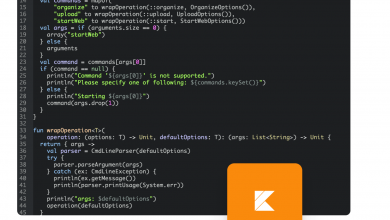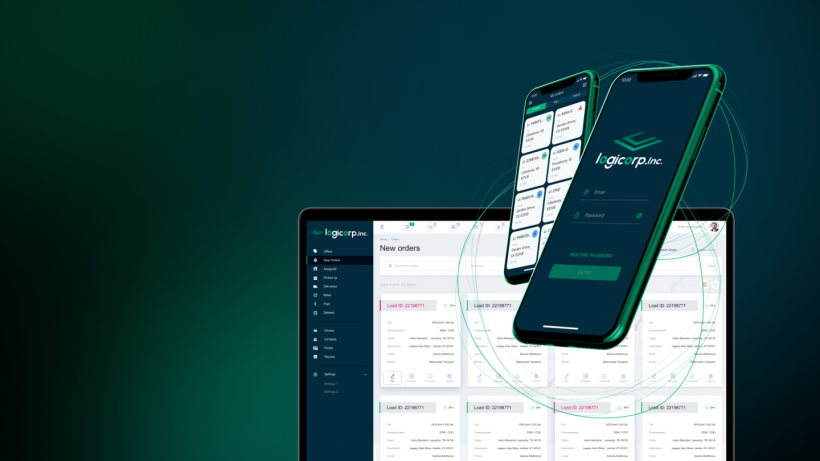A transportation management system (TMS) uses technology to assist companies in organizing, carrying out, and optimizing the car hauling process.Logicorp.inc Logistics , is a trucking company in the US and Canadian logistics market, that requested WEZOM create a TMS which could also be distributed as a SAAS service.
Our team determined the goal of the project was to create a flexible and up-to-date TMS for the distribution of transportation management and distribution tasks. After 12 months of work, we successfully developed a TMS ecosystem which allowed the client to run their company with maximum efficiency, as well as enabled the client to sell subscriptions to similar companies.
Why did Logicorp.inc Logistics need WEZOM?
This company had previously been using a digital dispatch service, but the disadvantages of this third-party platform outweighed its merits. The issue was it only supported 50 trucks per account so they had to buy and continuously switch between three separate accounts. The system was also outdated and relied mainly on old technology solutions.
The company began to think about developing their own solution. At first, they wanted to move away from third-party software, but then started thinking about future opportunities. The new TMS platform had the potential to be distributed among the transport operators in the SaaS model and take its niche in the market of TMS solutions.

What was requested?
Our client needed a digital truck management platform. This project quickly evolved from a major TMS platform into a completely developed SaaS service offering custom SaaS solutions for trucking companies across North America.
Logicorp.inc Logistics expected the platform to
- Receive orders, dispatch imports it, and assigns the driver to the trip.
The driver receives the order on the app, fulfills the necessary transportation requirements, and accepts the order. - Automatically generate documentation for the flight, which is accompanied by an electronic signature.
- All of this is automatically transmitted to the broker. In the best case - through the digital platform, in the worst case - by e-mail or fax.
The WEZOM team already had experience in developing such platforms and understood it was necessary to develop a TMS that closes all of these working steps, as well as, provides ample opportunities to manage routes, destinations and the loading of trailers.
What technology was used?
The client initially had no project terms of reference, and came to us with a service idea and a general vision of the final product. Our team gathered the client's requirements and ideas about the product and studied their experience with the third-party solution.

Several tools had to be developed to achieve the client’s goal such as:
- A server-side management part of the TMS.
- Mobile applications for iOS and Android driver.
- Web application for dispatchers, accountants and managers.
Our development tech-stack included:
- ReactJS
- Kotlin
- Swift
- Amazon Web Services
- PostgreSQL
On this basis our team formed top-level documentation with the project concept and outlined the platform structure, development approach and preferred technology. The base of the project was the React JS framework. The products created with it are very easy to develop and maintain, which was a very important aspect for our client. For convenient and secure data management our team turned to Amazon Web Services cloud platform. Native mobile apps were developed in Swift (for iOS) and Kotlin (for Android).

Our teams’ work approach
Having close communication with our client was very important to us. Without client’s feedback, the development team is often unable to assess whether their efforts meet the requirements of the project. Fortunately, in this case there was no issues with involvement and open communication.
The product owner from our client’s company became a part of the team. They understood the product and the specifics of development, as well as the business processes and what was important. Technical reporting was incorporated by our team, as we recorded the development progress in our client's profile in Jira, and so tracking the status of tasks was without limitations.
Every two weeks a sprint demonstration was for the client, which showed our results. The Team Leaders personally participated in the delivery of these sprints, answering questions, giving recommendations and commenting on technical parts. The Lead Project Manager communicated with the client on a daily basis.
Tasks were distributed amongst the team and tackled in sprints. Each sprint had clear tasks and deadlines, so the client always knew how long to wait and what the results would be. The development progressed according to SCRUM methods. This allowed us to ensure a decent technical level of the product and correctly prioritize tasks. The iterative approach gave us all creative freedom to propose any new ideas and features for the platform. If the client or our team had an idea for improvements, we put it into scope and discussed the priority of the new task.
At the end of the project, all of the ideas planned were successfully implemented. Overall development took about 20 two-week sprints, which is highly efficient for a development of this magnitude.
What did our team develop?
The team built a TMS ecosystem to distribute and monitor the tasks of the logistics business. The platform helps manage the fleet, simplifies document flow, provides effective means to control drivers' work and ensures business transparency.
The features included:
- The key hub of the ecosystem, the web application, which opens from any browser.
- The key roles in this system are administrator and dispatcher:
- The administrator creates accounts for dispatchers and fills them with data and grants them access.
- Dispatchers create and fill in the accounts of drivers, set tasks for them, and monitor their work.

- The application's admin panel makes it easy to create and moderate orders. Dispatch sheets and waybills are generated and pulled up automatically and then electronically signed.
- TMS provides dispatchers and managers of the system with a wide range of features:
- Electronic order board
- Management of loads by type of transport
- Taking into account the type of trailer and the characteristics of the cargo
- Dynamic management of transport routes and destinations
- Monitoring of trips by status at all stages of delivery
- Transport monitoring by geolocation
- Control of its technical condition
- Accounting tools (Financial reports, payroll reports, etc.)
- Personnel management tools (Databases for HR, tools for hiring employees, etc.)
Many modules for this TMS-system are individually designed to meet the needs of the client, so its functionality today goes far beyond the classical TMS-system. Native mobile applications for drivers, created for Android and iOS, work in conjunction with the control part.
In order to market the TMS, a lot of time was spent on SaaS and making it work. A select few businesses, including brokers and carriers, were able to use the system due to the SaaS itself. The orders from the brokers were placed on a shared list for pickup by various carriers. Additionally, there is interaction with the American database of brokerage firms, from which you can obtain TMS data.



Difficulties our team faced during development
The project was easily manageable, but it was not without its challenges. The work on the iOS driver app was complicated due to the system not working efficiently with sending data in the background.
Drivers needed to take pictures and upload them to the server to confirm their flight. The iOS platform has some difficulties with supporting the background download of images in minimized mode, and to implement it in-house, the developers had to work hard. In the end, forwarding pictures through the app works smoothly on all mobile OSes and this was solved without significant cost.
Results of our project
In the first stage, the client solved their key problem - they were able to get away from unsatisfactory third-party software and implemented a new custom development platform in the company. Now they don’t have to rely on outdated third-party technology and pay a monthly fee for it.
The new TMS doesn't just replicate the functionality of dispatch platforms. Today it has evolved into an IT ecosystem that combines logistics digital and CRM capabilities. The platform has relieved company management, simplified the work of dispatchers and drivers, and reduced costs. Supervising the work of the drivers has become much easier. The number of errors and bureaucratic oversights has decreased significantly, as well as the number of fines.
The new IT-platform at its disposal, our client entered the TMS-software market, as originally planned. Today they sell this solution to partners by subscription, which allowed them to quickly recoup their investment from the development and break even.
The work on this project has been a source of pride for us, both in terms of technical execution and business results. It's a prime example of how technology can impact the logistics market when applied in the right place at the right time.


